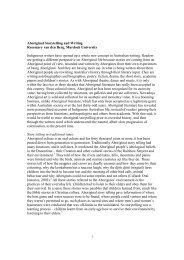Ferals: Terra-ism and Radical Ecologism in Australia - [API] Network
Ferals: Terra-ism and Radical Ecologism in Australia - [API] Network
Ferals: Terra-ism and Radical Ecologism in Australia - [API] Network
Create successful ePaper yourself
Turn your PDF publications into a flip-book with our unique Google optimized e-Paper software.
Graham St John<br />
Like other subcultural ensembles, feral is an <strong>in</strong>tentional sign system. Ferality ‘st<strong>and</strong>s<br />
apart’. It is ‘a visible construction, a loaded choice. It directs attention to itself; it<br />
gives itself to be read’. 38 However, at the risk of <strong>in</strong>cit<strong>in</strong>g a shallow rebellion, an<br />
‘alternative lifestyle feral’ must be politically active, must celebrate <strong>and</strong> defend.<br />
Ultimately, the feral spectacle must be <strong>in</strong> service of the cause. ‘Weekend ferals’ do<br />
not pose a threat. Accord<strong>in</strong>g to Banyalla, the ‘rebellion’ of the narcissistic ‘fashion<br />
feral’ rema<strong>in</strong>s substantively empty.<br />
Like other middle class subcultural milieux (eg, hippies), feral resistance is not<br />
conf<strong>in</strong>ed to the field of leisure. 39 Nor is it merely ‘symbolic’ or ‘ritual’ 40 <strong>and</strong>, therefore,<br />
conta<strong>in</strong>able. Furthermore, though edged <strong>in</strong>to the media spectacle, <strong>in</strong> the large, feral<br />
rema<strong>in</strong>s <strong>in</strong> the subterraneous marg<strong>in</strong>alia of ‘immediat<strong>ism</strong>’. 41 As such, its anarchic<br />
confrontational potential has been spared the degree of ‘recuperation’ via<br />
commodification that is the experience of other subcultures (eg, mod, hippy, punk<br />
<strong>and</strong> raver). This is the case as: there is no dist<strong>in</strong>ctively commodifiable feral literature<br />
or music; there is little evidence of an entrepreneurial ethos; cloth<strong>in</strong>g is DiY,<br />
<strong>in</strong>expensive <strong>and</strong> recycled; hair is not usually styled professionally; <strong>and</strong> there have<br />
been few feral ‘pop stars’. Feral signs are not converted <strong>in</strong>to mass produced objects<br />
on any scale comparable to punk. In Hebdige’s language, 42 they have not, at least<br />
yet, been ‘rendered at once public property <strong>and</strong> profitable merch<strong>and</strong>ise’. 43<br />
As the feral assemblage is significant, it is abundantly clear that style cannot be<br />
easily d<strong>ism</strong>issed. It ‘speaks’ of the values shared by adherents, radiat<strong>in</strong>g a transient,<br />
eco-conscious, non-material atav<strong>ism</strong>. However, while ferality’s spectacular aesthetic<br />
predom<strong>in</strong>ates <strong>in</strong> popular media representations, pivotal social, political <strong>and</strong> cultural<br />
traits have gone largely unnoticed.<br />
A key characteristic of ferality is its transience — semi-nomad<strong>ism</strong>. The rejection<br />
of ‘the parent culture’ — especially ‘the great <strong>Australia</strong>n dream’ of home-ownership<br />
— has sent these ‘nomads of the 90s’ 44 spirall<strong>in</strong>g out from their domestic orig<strong>in</strong>s.<br />
Ferality, which approaches the transhuman resistance to a settled life so strongly<br />
endorsed by Chatw<strong>in</strong>, 45 is cognate with the earlier ‘rucksack revolution’ declared<br />
by Kerouac <strong>in</strong> Dharma Bums. 46 Indeed, their immediate solution to a dissatisfy<strong>in</strong>g<br />
urban existence — mobility — corresponds with that of their Beat antecedents. 47<br />
Yet, also like Beats (<strong>and</strong> not to mention Travellers), ferals seek stability <strong>and</strong> belong<strong>in</strong>g<br />
with ‘like-m<strong>in</strong>ded’ others.<br />
Movement <strong>and</strong> residence are patterned by subsistence strategies. The fact that<br />
most are Centrel<strong>in</strong>k ‘clients’, <strong>and</strong> therefore State-dependent, challenges a purist<br />
def<strong>in</strong>ition of ‘feral’ as uncontrolled. Though welfare dependency tends to curtail<br />
mobility — with the requirement to submit ‘dole diaries’ <strong>and</strong> the pre-1998 threat of<br />
Case Management — the dole is an accepted part of the lifestyle. Welfare payments<br />
are often supplemented or superseded by other <strong>in</strong>formal, often temporary, sources<br />
of <strong>in</strong>come, <strong>in</strong>clud<strong>in</strong>g it<strong>in</strong>erant trad<strong>in</strong>g at small alternative markets or festivals, seasonal<br />
fruit pick<strong>in</strong>g, small-scale illicit substance trad<strong>in</strong>g <strong>and</strong> busk<strong>in</strong>g.<br />
The receipt of welfare, especially over the long term, is a circumstance around<br />
which reactionary elements launch offensives: ‘greenies’ are ‘bludgers’, ‘taxpayers’<br />
liabilities’. However, <strong>in</strong>siders rally around the conviction that the k<strong>in</strong>d of work <strong>in</strong>volved<br />
justifies tak<strong>in</strong>g ‘the government scholarship’. This is the case for Quenda. People<br />
<strong>in</strong> receipt, she argues, ‘are work<strong>in</strong>g real hard ... I couldn’t expla<strong>in</strong> to the typical<br />
person what I do’. There are actually two means by which Quenda personally<br />
‘works for the greater’. First, she performs ‘heal<strong>in</strong>g work’. Quenda is a member<br />
213


![Ferals: Terra-ism and Radical Ecologism in Australia - [API] Network](https://img.yumpu.com/13809010/6/500x640/ferals-terra-ism-and-radical-ecologism-in-australia-api-network.jpg)
![Dream and Nightmare in William Gibson's ... - [API] Network](https://img.yumpu.com/49298598/1/184x260/dream-and-nightmare-in-william-gibsons-api-network.jpg?quality=85)

!['Fuck All Editors': The Ern Malley Affair and Gwen ... - [API] Network](https://img.yumpu.com/42446228/1/184x260/fuck-all-editors-the-ern-malley-affair-and-gwen-api-network.jpg?quality=85)
![Polona Petek - [API] Network](https://img.yumpu.com/40542952/1/190x245/polona-petek-api-network.jpg?quality=85)
![to download as a PDF. - [API] Network](https://img.yumpu.com/35170825/1/184x260/to-download-as-a-pdf-api-network.jpg?quality=85)
![Edward Koiki Mabo: The Journey to Native Title - [API] Network](https://img.yumpu.com/33197148/1/184x260/edward-koiki-mabo-the-journey-to-native-title-api-network.jpg?quality=85)
![Gallipoli, Kokoda and the Making of National Identity - [API] Network](https://img.yumpu.com/31766380/1/184x260/gallipoli-kokoda-and-the-making-of-national-identity-api-network.jpg?quality=85)
![Indigenous Knowledge and Pharmaceuticals - [API] Network](https://img.yumpu.com/24108846/1/184x260/indigenous-knowledge-and-pharmaceuticals-api-network.jpg?quality=85)
![Big Chief Little Wolf: Wrestling, Radio and Folklore in ... - [API] Network](https://img.yumpu.com/12204748/1/184x260/big-chief-little-wolf-wrestling-radio-and-folklore-in-api-network.jpg?quality=85)
![Dark Tourism and the Celebrity Prisoner - [API] Network](https://img.yumpu.com/4348795/1/184x260/dark-tourism-and-the-celebrity-prisoner-api-network.jpg?quality=85)